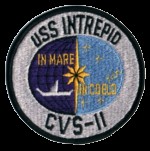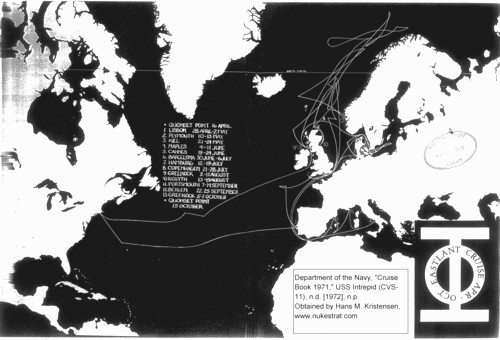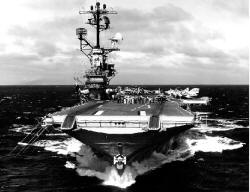The Visit by USS Intrepid (CVS-11) to Copenhagen, 1971
 The
USS Intrepid (CVS-11) arrived in Copenhagen in July 1971, only three
years after Denmark's non-nuclear policy was tested by
the crash of a
nuclear-armed bomber in Greenland. The visit created little controversy
and the Danish government turned a blind eye to what appears to be one of the clearest
violations of Denmark's prohibition against nuclear weapons in its
ports. The
USS Intrepid (CVS-11) arrived in Copenhagen in July 1971, only three
years after Denmark's non-nuclear policy was tested by
the crash of a
nuclear-armed bomber in Greenland. The visit created little controversy
and the Danish government turned a blind eye to what appears to be one of the clearest
violations of Denmark's prohibition against nuclear weapons in its
ports.
The USS Intrepid was converted from an attack carrier
(CVA) to an anti-submarine carrier (CVS) in 1969 following operations against
North Vietnam. The ship was transferred to the Atlantic Fleet and home
ported in Quonset Point, Rhode Island, then the center of all
carrier-based anti-submarine forces in the U.S. Atlantic Fleet. As an
anti-submarine carrier the mission of USS Intrepid was to hunt down and
destroy Soviet submarines. In the North Atlantic training for this mission brought
the ship deep into the Baltic Sea and high up into the Norwegian Sea in
1971 and 1972 on exercises.
The 1971 Deployment
The USS Intrepid formed the center of Task Force 83.2,
which during the extended overseas deployment encountered "considerable
Soviet surveillance." Embarked on the USS Intrepid during the 1971
deployment were Air Antisubmarine Squadron TWENTY-FOUR (VS-24) and Air Antisubmarine Squadron TWENTY-SEVEN (VS-27)
wings. The task force also included several other
nuclear-capable warships, including the
diesel submarine USS Greenfish
(SS-351) which also carried nuclear weapons during the deployment and
visited Århus, Denmark, while the carrier was in Copenhagen. The
extensive deployment reached from the Mediterranean to the Baltic Sea
and Barents Sea (see map).
|
USS Intrepid
(CVS-11) Operations April-October 1971 |
 |
| The route of USS Intrepid (CVS-11) during
its extended overseas deployment to the Mediterranean Sea
and Northern Europe in 1971. Click on the map to download a
high-resolution PDF-version (requires
Adobe Acrobat). |
The task force left Quonset Point on April 16 for a
visit to Lisbon, Portugal, after which it steamed north for NATO
exercise Rusty Razor and a port visit to Plymouth in the United Kingdom.
After Plymouth, USS Intrepid and part of Task Force 83.2 entered the Kattegat, transited the narrow Danish Straits on May 16 to became the first U.S.
aircraft carrier to conduct operations in the Baltic Sea.
During the operations in the "Sea of Peace," the USS
Intrepid conducted flight operations and sailed to within only 20 miles of the Soviet coastline.
Continuous anti-submarine operations were conducted and "numerous Soviet
submarines were detected, prosecuted and kept under surveillance." An
anti-submarine warfare demonstration was performed for Kontra-Admiral
Kierkegaard and visiting Swedish dignitaries. The operations in the
Baltic were later heralded by U.S. Chief of Naval Operations Admiral
Zumwalt to be "superb in a situation that demanded no less."
|
USS Intrepid
(CVS-11) |
 |
|
The nuclear-armed anti-submarine aircraft carrier
USS Intrepid (CVS-11) visited Copenhagen in 1971 and 1972. |
After the Baltic operations and a four-day visit to
Kiel, West Germany, USS Intrepid left the Baltic and sailed south to the
Mediterranean Sea where it conducted port visits in France, Italy, and
Spain. During an anti-submarine exercise with the
USS Greenfish, an
"intruder submarine contact was detected, prosecuted for 3 hours,
photographed and evaluated as a Soviet Victor Class SSN."
On July 6, the USS Intrepid sailed north again to
Hamburg, West Germany, after which the carrier continued to Copenhagen
where it arrived on July 21 for a week stay.
On July 28, the USS Intrepid departed Copenhagen
enroute Greenock, Scotland, and after a week in port the carrier sailed
north into the Norwegian Sea for NATO exercise Alert Lancer. During the
exercise, the carrier's anti-submarine squadron gained numerous contacts
with Soviet November class and diesel submarines.
Following a visit to Portsmouth in the United Kingdom
and Bergen in Norway, USS Intrepid steamed far north into the
Norwegian Sea for NATO exercise Royal Night. This was an advanced strike
fleet exercise where USS Intrepid joined forces with two other aircraft
carriers (USS Independence and HMS Ark Royal). USS Intrepid's mission
was to "sanitize" the waters for enemy submarines to enable the strike
carriers to sail far enough north for their aircraft to strike the Kola
Peninsula.
|
B57 Nuclear
Strike/Depth Bomb |
 |
|
The light-weight B57 nuclear strike/depth bombs
carried onboard USS Intrepid (CVS-11) during its port visit to
Copenhagen in 1971 each had a yield of 15-20 kilotons.
Source:
www.navynucweps.com |
Nuclear Weapons Operations
After the visit to Copenhagen and the completion of
the extended deployment deep into the Baltic Sea and Norwegian Sea, the
USS Intrepid returned on October 15 to its homeport in Quonset Point,
Rhode Island, on the U.S. East Coast. Two more nuclear weapons security
exercises were held inport before the ship sailed to Naval Ammunition
Depot (NAD) Earle in New Jersey to offload all weapons prior to a
shipyard period. The weapons offloaded at Earle included the ship's
complement of nuclear weapons, an operation that took approximately
three hours to complete. The ship's deck log explicitly mentions that
the offload included nuclear weapons and that it was the Chopsticks team
that carried out the operation: "12:15 Went to CHOPSTICKS stations for
offload of Nuc Weapons. 15:12 Secured from CHOPSTICKS."
|
USS Intrepid
(CVS-11) Nuclear Weapons Offload After Copenhagen |
 |
| Excerpt from USS
Intrepid (CVS-11) Deck Log documenting offload of nuclear
weapons after an extended overseas deployment and port
visit to Copenhagen, Denmark, in 1971. Click the image to
download high-resolution PDF-version of deck log pages
(requires
Adobe Acrobat). |
Even if one believe that the USS Intrepid offloaded the nuclear weapons in another port
before arriving in
Copenhagen and then picked them up again after the visit -- something
retired U.S. Navy officials have always insisted the U.S. Navy never did, the
route of the USS Intrepid rules out that possibility: None of the ports
visited prior to Copenhagen were re-visited after Copenhagen (see map
above). There is also no mentioning in the documents that the weapons
were offloaded to another warship -- something retired U.S. Navy
officials also have insisted the U.S. Navy avoided -- prior to the
arrival in Copenhagen.
The nuclear operations of the USS Intrepid around the
time of its 1971 port visit to Copenhagen, as recorded in the ship's
command history, deck log, and other official documents, are listed in
the following table:
|
USS
Intrepid Nuclear Operations Around Denmark Visit, 1971 |
|
Date |
Description & Remarks |
|
01/07/71 |
Following
a brief shipyard period to repair storm damage, a nuclear
weapons accident exercise was held onboard while inport
Quonset Point, RI.
Deck Log:
14:37 Broken CHOPSTICKS drill. Material condition ZEBRA set. |
|
01/18-02/01/71 |
Conducted
antisubmarine training against the nuclear submarines USS
Nautilus (SSN-571) and USS Skate (SSN-578). |
|
02/08/71 |
Inport
Quonset Point, RI. Designated nuclear weapons personnel
returning to the ship included Gunner's Mate Technician
(GMT) Greenovich, D B160924. [The Deck Log entry is listed
on 9 February.] |
|
02/18/71 |
An
ammunition onload took place while inport Quonset Point, RI.
Deck Log:
14:00 Secured pier to automobile traffic while loading
ammunition. 14:45 Ammunition load complete. |
|
02/25/71 |
Nuclear
weapons handling was conducted onboard while the ship was
underway off the U.S. East Coast.
Deck Log:
12:30 Called away CHOPSTICKS stations. 12:55 Commenced
operation CHOPSTICKS. |
|
02/28/71 |
Underway
as before. More nuclear weapons handling conducted.
Deck Log:
8:30 Called away CHOPSTICKS. 10:13 Secured from CHOPSTICKS. |
|
03/04/71 |
Another 28
degree roll is suffered during a storm following an exercise
off the East Coast. The roll "caused considerable damage
throughout the ship." |
|
03/22/71 |
Inport
Quonset Point, RI, where ammunition was loaded onboard.
Deck Log:
8:20 Commenced taking on ammunition.15:45 Secured from
taking on ammunition. |
|
03/30/71 |
Another
ammunition onload occurred while inport Quonset Point, RI.
Deck Log:
10:00 Commenced loading ammunition. 11:30 All ammunition on
deck. Ammunition onload complete. |
|
04/05/71 |
More
ammunition was loaded onboard.
Deck Log:
13:40 Commenced loading ammunition. 14:10 Completed
ammunition on load. |
|
04/13/71 |
A nuclear
weapons accident exercise was held while inport Quonset
Point, RI.
Deck Log:
11:00 Commenced CHOPSTICKS operation. 13:45 Commenced
Broken CHOPSTICKS and general quarters. 14:20 Secure from
CHOPSTICKS. |
|
04/16/71 |
Departed
Quonset Point, RI, for a six-month deployment of extended
overseas operations in the Mediterranean, Eastern Atlantic,
and Baltic Sea
operations IAW COMASWGRU FOUR OPORD 4-71.
During this cruise, the ships Weapons
Department included a Special Weapons (W) Division team of
19 personnel. Air Antisubmarine Squadrons TWENTY FOUR
(VS-24) and TWENTY SEVEN (VS-27) were embarked. The escort
includes the conventionally powered submarine USS Greenfish
(SS-351). |
|
04/16/71 |
A nuclear
weapons accident exercise was conducted onboard while
underway from Quonset Point, RI, enroute Portugal.
Deck Log:
14:03 Commenced Broken CHOPSTICKS drill. Sounded general
quarters. 14:23 Set CIRCLE WILLIAM throughout the ship.
14:56 Relaxed CIRCLE WILLIAM. 15:09 Set material YOKE. 15:20
Secured from general quarters. |
|
04/17/71 |
Another
nuclear weapons security exercise while underway enroute
from Quonset Point, RI, to Lisbon, Portugal.
Deck Log:
7:00 Called away CHOPSTICKS stations. 9:19 Penetration. 9:23
Secure from penetration drill. 15:26 Secured from
CHOPSTICKS. |
|
05/03/71 |
After
Lisbon, Portugal, the ship departed for Plymouth, England, in company
with units of Task Group 400.1. Transit IAW RUSKY RAZOR
Joint Exercise OPORD 1-71. |
|
05/16/71 |
Following
a visit to Portsmouth, England, the ship continued to a port
visit to Kiel, West Germany, and operations in the Baltic
Sea. The transit to Kiel was done IAW COMASWGRU FOUR OPORD
4-71.
The USS Intrepid become the first U.S.
carrier to conduct flight operations in the Eastern Baltic.
Escorted by three other U.S. warships, the operations
brought the ship to within only 20 miles of the Soviet
coastline. Soviet surface, submarine and air surveillance
was considerable. Admiral Zumwalt, U.S. Chief of Naval
Operations, subsequently praised the ship's performance as
"superb in a situation that demanded no less." Numerous
Soviet submarines were detected, prosecuted and kept under
surveillance.
During operations in the Baltic the ship passed through the
Bornholmsgat from the Baltic Sea.
When transiting the Danish Straits, the Danish pilots
Captain Jørgensen and Hansen were brought onboard by
helicopter. |
|
05/26/71 |
Following
the visit to Kiel, West Germany, the USS Intrepid was
dispatched to the Mediterranean Sea where a Soviet Victor
class SSN was detected and photographed. The transit
occurred
IAW COMASWGRU FOUR LOI 4-71.
During passage out through the Danish Straits, the Danish
pilots Captain Thesmer and Captain Nielsen embarked. |
|
07/21-28/71 |
In
Copenhagen, Denmark, following a transit from the
Mediterranean. Also
present was USS N. K. Perry (DD-883).
Danish docking pilot was Captain Jacobsen, and Channel Pilot
was Captain Petersen.
Upon arrival the ship received visits from several
high-ranking officials, including the U.S. Ambassador to
Denmark, Danish Chief of Defense, Commander of Copenhagen
Captain Kisum and Captain Prause.
The inport
period only lasted until 25 July, when the ship was moved
outside port and anchor was dropped at Middelgrund, still in
Danish territorial waters. This move occurred while the U.S.
Ambassador was onboard.
When departing, Danish pilots were Captain Thodsen and
Captain Albertsen. |
|
09/22-25/71 |
Inport
Bergen, Norway,
Also
present were USS Kennedy (DD-850) and USS Taussig
(FF-1030). During the port call the ship was visited by
Norwegian Minister of Defense and the German Minister of
Defense.
The visit took place following operations in
the Norwegian Sea against the submarines USS Bluefish and
USS Sirago and “Soviet vessels of opportunity.” Numerous
contacts were made with Soviet November class and diesel
submarines. The U.S. Ambassador to Norway and Norwegian
Minister of Defense officials visited the squadron during
this period.
Following the visit the ship participated in
NATO exercise Royal Knight. |
|
10/15/71 |
Returned to
Quonset Point, RI. |
|
10/16/71 |
While
inport Quonset Point, RI, the ship offloaded ammunition.
Deck Log:
13:06 Commenced offloading ammunition. 14:19 Completed
offloaded ammunition. |
|
10/20/71 |
A nuclear
weapons security drill was held while inport Quonset Point,
RI.
Deck Log:
1137 Conducted penetration drill. 11:41 Secured from
penetration drill. |
|
10/28/71 |
Another
nuclear weapons security drill was conducted. Inport Quonset
Point, RI.
Deck Log:
14:02 Held Penetration drill. 14:07 Secured from penetration
drill. |
|
11/30-12/01/71 |
At NAD [NWS]
Earle, NJ, for ammunition offload prior to shipyard
period. Weapons offloaded included nuclear weapons.
Deck Log:
(11/30) 9:50 Commenced offload of ammunition. (12/01) 00-04
Ammunition off-load is in progress. 12:15 Went to CHOPSTICKS
stations for "offload of Nuc Weapons." 15:12 Secured
from CHOPSTICKS. 15:15 Completed offloading of ammo, 283
tons total. |
Operations in 1972 and 1973
The USS Intrepid returned to Europe
and to Copenhagen in 1972, and the documents strongly suggest that
the ship was once again nuclear armed. The Chopstick deck handling
crew was drilled in how to respond to a nuclear weapons accident.
The drill was preparation for a subsequent nuclear weapons
certification inspection which the ship must pass in order to have
nuclear weapons onboard.
The
Nuclear [Navy] Technical
Proficiency Inspection (NTPI) was passed in May 1972 "with the
Squadron’s loading teams performing their loads satisfactorily.” Yet
the documents reveal that part of the carrier's response to a
simulated nuclear weapons accident was not sufficient, so before USS
Intrepid was allowed to leave for Europe with nuclear weapons
onboard, the crew underwent additional training to pass the
certification. Finally, in late June, only a month before the ship
arrived in Copenhagen, the USS Intrepid passed its certification
inspection. While underway to Denmark, a nuclear weapons security
practice was held onboard. USS Intrepid arrived in Copenhagen on
July 25 for a week long visit.
After the visit, USS Intrepid steamed
north into the Norwegian Sea to conduct anti-submarine operations.
During the
operations in the Norwegian Sea, the carrier crossed the Arctic
Circle and sailed as high north as 75N 27.16E and as far east as
72.25.2N 31-40.8E, the farthest east a U.S. aircraft carrier had
ever been in that region up to that time. "Needless to say, Soviet
interest in the ship's activities was extremely high," the ship's
Command History stated.
|
USS
Intrepid (CVS-11) Underway |
 |
|
During operations in the Norwegian Sea in
1972, the USS Intrepid (CVS-11) sailed farther east toward
the Soviet Kola Peninsula than any other U.S. aircraft
carrier until that time.
Source: U.S. Navy. |
After a visit to Bergen in Norway,
USS Intrepid returned to its home ports in Quonset Point, RI. During
the transit, more nuclear weapons training was held onboard. Once
back in the United States, the USS Intrepid began upgrading from
anti-submarine carrier to strike carrier. The air wing was added
more A-4E Skyhawk strike aircraft
which "gave the
INTREPID a strike capability and enabled her to subsequently
commence phasing into the 'CV' concept." The anti-submarine mission
was retained as well.
The new strike mission was practiced
during an overseas deployment to the Sixth Fleet in the
Mediterranean Sea beginning in November 1972. A few days before
arriving in Athens, Greece, the crew practiced bringing nuclear
weapons up from the Special Weapons Magazine to the strike aircraft
on the flight deck.
During the Mediterranean deployment, the USS Intrepid
conducted "two launch Sequence Plans and numerous single aircraft
special weapons loads."
The 1973 Mediterranean cruise would
be USS Intrepid's last overseas deployment. The carrier returned to
the U.S. East Coast in May 1973, but before it arrived in its
homeport the USS Intrepid conducted a unique offload of nuclear
weapons and other ammunition at sea to the ammunition ship USS Santa
Barbara (AE-28). The nuclear portion of the weapons transfer took
three and a half hours. It is unclear why the navy decided to
conduct this risky nuclear operation at sea, a procedure the U.S.
Navy normally tried to avoid, rather than offloading the nuclear
weapons at NAD Earle as it was done in 1971.
The USS Intrepid
finally
returned to NAS Quonset Point, RI, two days later where it began
preparations for transferring to the reserve fleet and eventually
decommissioning a year later on 15 March 1974. USS Intrepid today
functions as the
Intrepid Sea-Air-Space Museum in
New York City.
©
Hans
M. Kristensen |
www.nukestrat.com | 2004-2005
|

